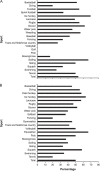Clinical Recovery Timelines After Sport-Related Concussion in Men's and Women's Collegiate Sports
- PMID: 33626145
- PMCID: PMC9528707
- DOI: 10.4085/601-20
Clinical Recovery Timelines After Sport-Related Concussion in Men's and Women's Collegiate Sports
Abstract
Context: Researchers have identified sex differences in sport-related concussion incidence and recovery time; however, few have examined sex differences in specific recovery trajectories: time to symptom resolution, return to academics, and return to athletic activity across collegiate sports.
Objective: To examine sex differences in sport-related concussion recovery trajectories across a number of club and varsity sports with different levels of contact.
Design: Descriptive epidemiology study.
Setting: Collegiate varsity and club sports.
Patients or other participants: Sport-related concussions sustained by student-athletes (n = 1974; women = 38.8%) participating in Ivy League sports were monitored between 2013-2014 and 2018-2019.
Main outcome measure(s): Athletic trainers collected concussive injury and recovery characteristics as part of the Ivy League-Big Ten Epidemiology of Concussion Study's surveillance system. Time to symptom resolution, return to academics, and return to limited and full sport participation were collected. Survival analyses determined the time from injury to each recovery outcome for male and female athletes by sport. Peto tests were used to compare recovery outcomes between men's and women's sports and by sport.
Results: The median (interquartile range [IQR]) was 9 days (IQR = 4-18 days) for time to symptom resolution overall, 8 days (IQR = 3-15 days) for return to academics, 12 days (IQR = 8-23 days) for return to limited sport participation, and 16 days (IQR = 10-29 days) for return to full sport participation. We observed differences overall between sexes for median time to symptom resolution (men = 8 days [IQR = 4-17 days], women = 9 days [IQR = 5-20 days]; P = .03) and return to academics (men = 7 days [IQR = 3-14 days], women = 9 days [IQR = 4-17 days]; P < .001) but not for median time to return to athletics (limited sport participation: P = .12, full sport participation: P = .58). Within-sport comparisons showed that women's lacrosse athletes had longer symptom resolution (P = .03) and return to academics (P = .04) compared with men's lacrosse athletes, whereas men's volleyball athletes took longer to return to limited (P = .02) and full (P = .049) sport participation than women's volleyball athletes.
Conclusions: Recovery timelines between sexes were different. Athletes in women's sports experienced longer symptom durations and time to return to academics compared with men's sports, but athletes in men's and women's sports presented similar timelines for return to athletics.
Keywords: academics; athletics; female athletes; return to learn.
© by the National Athletic Trainers' Association, Inc.
Figures





References
MeSH terms
LinkOut - more resources
Full Text Sources
Other Literature Sources
Medical

